Published
on 1
Mar 2010
|
All rights reserved.
|
|
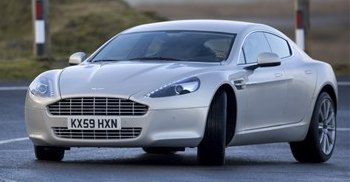
|
Aston builds a four-door sports car...
|
Aston
Martin CEO Ulrich Bez
said Rapide is "the only four-door
sports car in the world". A bold statement it might sound, but I
think it is true. The most sporting 4-door performance cars currently
on the market are Maserati Quattroporte and Porsche
Panamera. They are very fast and capable, unquestionably,
but neither are built on sports car platforms - in the case of Porsche,
it is even built on an SUV platform. Aston Martin's latest four-door
offering is different. It is derived from the VH platform of DB9,
employing much the same V12 engine, double-wishbone suspensions and
even exterior
design ! See it as an extension of DB9 and it won't be far off.
Nevertheless, the statement of Dr. Bez has the flip side. It implies
Aston Martin, now under new owners, lacks fund to develop a dedicated
4-door platform. The fact that no one else builds "four-door sports
cars" is because
their market demand is questionable, or at least unproven. If Dr. Bez
is given sufficient funding, do you think he would still be determined
to do a 4-door sports car ? It goes without saying that a 4-door based
on sports car platform would have to compromise on accommodation,
comfort and luggage carrying capability. Think what would happen if
Porsche
derived 911 into a 4-door. Or Aston Martin's own Lagonda became a
four-door version of V8 Vantage.
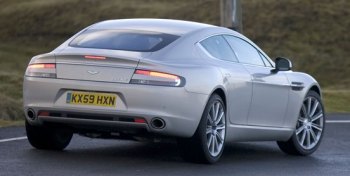
|
The fact that no one else builds
"four-door sports cars" is because their market demand is
questionable...
|
However, given the financial
constraints, you can't help
admire what Aston Martin has achieved with Rapide. This car looks
gorgeous. It keeps the emotion of DB9 intact in a much longer package,
and even inject some extra thrill with four butterfly doors which open
outward and slightly upward (note: Dr. Bez used a more romantic
description instead, swan wings).
Its interior is very well crafted. Rear passenger space is
not as bad as imagined, and on the run its refinement is even
surprisingly good. Above all, it feels more exclusive than Porsche and
Maserati. I would say not even Bentley has that sense of occasion. This
is probably
what Dr. Bez wants most.
The Rapide started life from DB9. As its aluminum VH platform is
flexible to expand both longitudinally and transversely, some 250 mm
has been inserted into its wheelbase and 55 mm has been added to its
width. The roof is raised by 40 mm in order to make room for rear
passengers without corrupting the flowing roof line. The whole car now
measures in excess of 5 meters long and weighs nearly 2 tons.
Ridiculously, it weighs the same as Porsche Panamera Turbo, which
employs steel monocoque chassis and incorporates four-wheel drive.
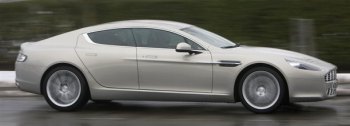 |
It keeps the emotion of DB9 intact in
a much longer package...
|
The aluminum space frame chassis by extrusions has another
disadvantage: to achieve the same strength as steel ones, its
structural parts have to be larger, eating more space. As a result, the
rear door apertures are unusually small, even though the doors look
large enough from outside. Entering the rear seats takes special
precaution - step across the sill, put one foot into the tight foot
well, thread your body into the deep bucket seats while keep your head
from hitting the sloping roof. No other four-door saloons are more
difficult to get into.
The rear seats are mounted close the floor because of the low roof
line. This mean the seating position is not as comfortable as that of a
conventional saloon. However, there is enough head and leg room if you
are no taller than 6 feet. Inevitably, the environment feels snug,
thanks to a huge
transmission tunnel separating the seats and the shallow glass all
round, also the fact that the rear passenger's vision is seriously
blocked by the front headrest. Sitting at the back is somewhat like
captured in prison, albeit a prison luxuriously trimmed in stitched
leather and real alloy. The front vision problem may be overcome by
ticking the optional DVD entertainment system, which adds LCD screens
to the back of the front seats. It looks more economy class than first
class though. The large transmission tunnel doubles as armrest for the
rear passengers. It also provides a control panel on which you can
control the entertainment system, air conditioning and seat adjustment.
Following the control panel is a couple of cup holders, elegantly
trimmed in alloy and leather. The decoration is classy enough to
convince adults to spend an hour or two at the back. How about
cross-country trips ? No thanks. It's best leave to kids.
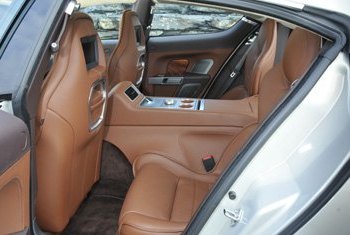
|
Sitting at the back is somewhat like
captured in prison, albeit a prison luxuriously trimmed in stitched
leather and real alloy.
|
The Rapide has a hatchback door and its rear seats fold to
expand luggage space. It is unlikely to be used as airport express
though, because the boot measures only 317 liters, smaller than your
family hatch. Even with the rear seats collapsed, luggage space is
still less than
900 liters.
As expected, the dashboard comes straight from DB9. With plenty of
bespoke buttons, wood and alloy, it looks classier yet more traditional
than its mass market competitors. The only let down is the
Volvo-sourced satellite navigation, which is at odds with the
surrounding expensive materials.
Unlike DB9, the dashboard of Rapide is decoupled from the windscreen
via foam to eliminate squeaks. Similarly, to isolate the cabin from
road harshness, the rear subframe is now mounted to the chassis via
rubber bushings. The steering column is rubber insulated as well to
reduce kickback. Double glazing windows and new window sealing
technology are employed to insulate wind noise. Such NVH engineering
know-hows are elementary to most other luxurious car makers, but they
are new to Aston Martin and took it a lot of time to learn.
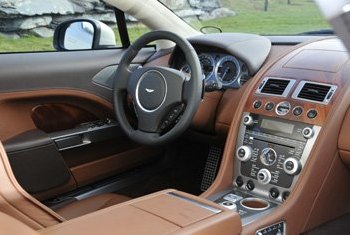
|
The dashboard is decoupled from the
windscreen via foam to eliminate squeaks... All NVH know-hows are are
new to Aston...
|
The suspensions are basically the same as DB9's, except with
beefed up lower wishbone up front to take on the increased weight.
Bilstein adaptive dampers are once again standard. As for braking,
Brembo supplies the latest dual-cast brake discs, whose lightweight
aluminum hubs should help improving ride quality.
In the engine bay is the high-torque version of Aston Martin's 5935
c.c. V12. Since its birth on DB7 Vantage some 11 years ago, this engine
hasn't changed much, just like some good old British traditions
(ridiculously, it is actually built at Cologne by Ford). It still goes
without modern technologies like variable valve timing or direct
injection. What it has is plenty of displacement, and an angry roar
that sets it apart from the smoother, higher-pitched Ferrari V12. In
the high-torque version, maximum torque is lifted to 443 lb-ft at 5000
rpm, compared to 420 lb-ft / 5750 rpm on DBS. The trade-off is less
top end power, i.e. 470 hp at 6000 rpm instead of 510 hp at 6500 rpm.
Aston believe few people want a manual transmission in a four-seater
like this, so the only one offered is ZF's 6-speed automatic, completed
with manual mode and shift paddles, of course.
On the Road
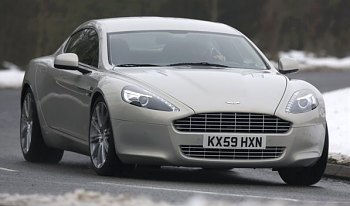
|
The big V12 isn't quite as
enthusiastic for rev. It is more about effortless performance.
|
On
the
road, the Rapide is not as rapid as its name suggested. 0-60 mph in 5.1
seconds is hardly headline today. Porsche Panamera Turbo does that in
less than 4 seconds. Maserati Quattroporte GTS is about the same as
Aston, but its rev-hungry V8 makes you feel it is faster and more
thrilling. In contrast, the big Aston feels lazier, partly because of
its weight, partly because of its linear torque delivery. Sure, the big
V12 has plenty of reserve, but it isn't quite as enthusiastic for rev.
It is more about effortless performance. However, it must be pointed
out that the V12 does produce a stirring noise that not many rivals can
match.
What really surprises is refinement. The Rapide's adaptive suspension
is firm but very well damped over a variety of surfaces, including
B-roads. On sharp bumps or small irregularities, I bet it is more
supple than the Panamera with air suspensions, let alone the stiffly
sprung Quattroporte GTS. That must be a big surprise for its sports car
look. Apart from ride quality, its cabin is also pretty well insulated
from wind whisper and tire roar. Only at very high speed the large,
295/35ZR20 tires may generate road noise to the extent of disturbing.
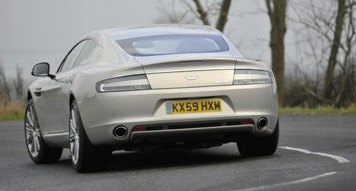
|
It flows through bends with poise and
composure only available to sports cars with low center of gravity,
which it is.
|
But above all, the most outstanding
aspect is handling.
Despite of its excessive length, the Rapide is actually very well
balanced, more so than DB9 and DBS. It flows through a series of bends
with poise and composure only available to sports cars with low center
of gravity, which it is. Its steering is the best yet for Aston Martin
- light yet accurate, engaging yet free of harshness. Faster steering
ratio offsets the longer wheelbase, so its turn-in is sharp enough. At
the limit, the big Aston runs into light understeer, but by applying
throttle you can swing its tail out in classical way. Try this in a
Panamera !
On really challenging roads, the Rapide feels smaller than it is. The
same cannot be said to Porsche. This effectively rules the latter out
of contention as the best 4-door sports saloon in the world, even
though it boosts the strongest performance. Only Maserati is on the
same plane as Aston. If you need proper cabin and luggage space for
four adults, or if your budget is £100,000 rather than
£140,000, Maserati will be no-brainer. If you want a four-door
saloon with sports car handling and feel, then Rapide will be the only
choice.
Considering most customers of this class have multiple cars in their
garages, most likely including a sports car and a Benz or Bentley,
there won't be too many people interested in purchasing a 4-door,
4-seater sports car. That is why Dr. Bez is targeting at 2,000 sales
per year, just a tenth of the sales target of Porsche Panamera. As the
Gaydon factory does not have enough space, production of all Rapides
will be subcontracted to Magna Steyr in Austria. |
Verdict:     |
| Published on 28
Mar
2013 |
All rights reserved.
|
|
Rapide S
|
|
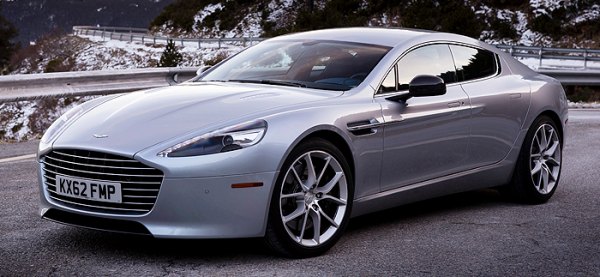
|
Aston Martin has been busy
updating its cars recently. Following Vanquish II, DB9 Mk2 and V12
Zagato, the limelight falls on its four-door saloon Rapide. The latest
version is called Rapide S. Visually, it differs from the old car by
mainly a far more prominent mouth. It might divide opinions, but after
a while you will get used to it and start appreciating the stronger
character it brings. Moreover, the huge grille serves to remind you
about the more powerful V12 sitting behind it, which is the focus of
this update.
This engine is practically the same AM11 V12 that is found in the new
Vanquish and DB9. It is mounted some 19 mm closer to the ground to
lower center of gravity, which undoubtedly benefit handling, while
deliberating space under the bonnet to pass stricter pedestrian safety
regulations. The engine itself has a lot of improvement, such as double
variable valve timing (previously there was none), lightweight hollow
camshafts, a freer flowing intake manifolds, larger throttle bodies and
CNC-machined combustion chambers, to name a few. Its smoother breathing
frees up its top end delivery, lifting peak horsepower from 477 hp at
6000 rpm to 558 hp at 6750 rpm. That is quite a dramatic improvement
considering its displacement remains unchanged. Torque curve improves,
too. Not only maximum torque is lifted from 443 to 457 lbft, there is
at least 30 lbft of extra torque available at any rev below 4000 rpm.
At 2500 rpm, it is 10 percent stronger than before.
Consequently, tractability is enhanced. On the road, you can feel the
extra punch it generates, although the improvement is nowhere as
dramatic as the effect of turbocharging. It allows you to work less
hard on throttle. That said, the true color of the V12 still lies at
the upper rev range. It tempts you to stretch it, rewards you with an
amazing noise that is incomparable in the world of 4-doors. While its
official 0-60 mph time of 4.7 seconds sounds ordinary these days, it is
more satisfying than the old car's 5.1 ticks. In reality, the
turbine-smooth manner, the beautiful orchestra from 12 cylinders and
the sharp handling combine to make it feel far faster than it is.
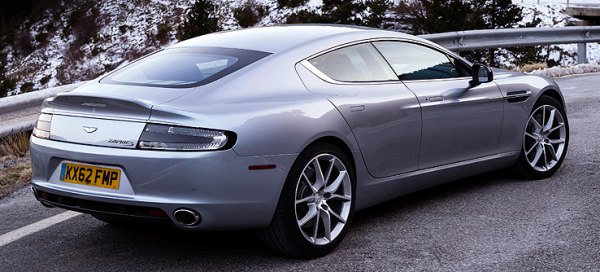
|
Yes, the biggest asset of the Rapide is still its sports car handling
and feel. It goes without saying that it is still the only 4-door
saloon in the world that is genuinely converted from a sports car. Its
low center of gravity, its all-double wishbone suspensions, its good
weight distribution and low polar moment of inertia – thanks to an
engine mounted rear enough and a transaxle gearbox – all serves to
deliver sports car balance, hence sharp turn-in, stable cornering and
neutral handling. A 4-wheel-drive Panamera Turbo S might be ultimately
quicker from A to B, but the big Aston is certainly more feelsome and
entertaining. It feels sharper and more eager to steer. It places its
huge body millimeter accurate so that you feel like driving a much
smaller sports car. Its hydraulic steering provides road feel and
consistency that rivals envy. Most important, its handling is highly
interactive – you can power slide the car with throttle and counter
steer just as a good sports car does. Just as Dr. Bez said, it "remains
a sports car at heart".
Meanwhile, the suspension of Rapide S is made more versatile with a
revised adaptive damping system. Now it features 3 selectable settings
instead of 2. The standard mode has been softened a bit to cope better
with poor surfaces, while Track mode has been added above Sport mode to
deal with the smoothest roads like Autobahn. As a result, it is able to
provide luxury car ride comfort as well as sports car handling
depending on needs.
With more performance and a more versatile ride, Rapide S is more
desirable than ever. If not because of its limited rear seat
accommodation, we could have given it the maximum rating.
|
Verdict:     |
| Published
on 8
Aug
2014 |
All rights reserved.
|
|
Rapide S 2014 update
|
|
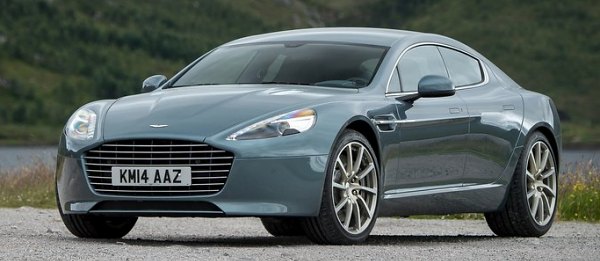
|
Like Vanquish, Rapide S is
also receiving the new ZF 8-speed automatic transaxle to boost
performance, smoothness and fuel efficiency. With 2 additional ratios
to play with, its top speed is raised dramatically from 190 to 203 mph,
not only setting a new record for Aston but also beating Bentley Flying
Spur W12 as the world’s fastest 4-door saloon – if you really see it
as a saloon. Meanwhile, 0-60 mph sprint gets a similar improvement from
4.7 to 4.2 seconds. Mind you, it doesn’t feel as quick as some
super-torquey turbocharged sports sedans, but the Aston V12 compensates
with a great sound and linear power delivery which aids the handling
and balance of the car. Like Vanquish as well, the V12 gets a new
management system to communicate with the new gearbox and by the way
releases another 2 horsepower and 8 lbft of torque. With the help of
the 8th gear – which is actually an overdrive, while top speed is
reached at 7th – fuel economy improves a little as well.
On the road, the new gearbox shifts so much smoother and faster than
the old 6-speeder so that acceleration is now seamless. The new engine
mapping brings quicker throttle response to delight the driver further.
Comparatively, fewer improvements can be found on the chassis. The
front brake discs have grown to 400 mm to deal with the new found pace.
The electronic adaptive damping has been retuned to separate Comfort
and Track modes further apart. The rear bushings have been
stiffened a little. In the softest setting, the Rapide S still rides
well on country roads, but in sportier settings it gets tauter body
control at the price of more harshness. This makes it even more obvious
than before as the world’s only 4-door sports car.
|
Verdict:     |
Published
on 23
May 2019
|
All rights reserved.
|
|
Rapide AMR
|
|
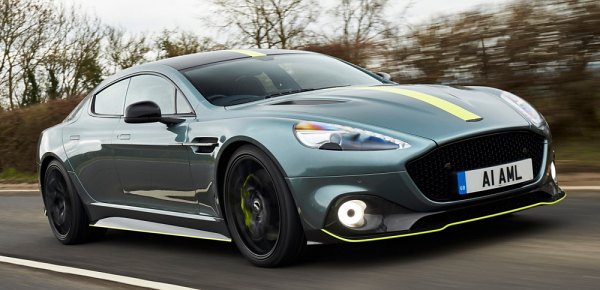
|
|
The
last hurrah for Aston Martin's naturally aspirated V12 as well as the
VH-platform.
|
|
Production of the Aston
Martin Rapide is coming to the end. The car was born in 2010, yet its
underpinnings could be traced back to the 2004 DB9, so it is long
overdue for replacement. Starting from next year, the Rapide will be
indirectly replaced by the DBX crossover and later on a Lagonda
electric saloon. This means, the world will lose the only true 4-door
GT. Before that happens, Aston is going to build 2 batches of run-out
specials. One is the Rapide AMR shown here. It is the last hurrah for
the Aston Martin naturally aspirated V12, because newer Astons have
already turned to turbocharging. Another is Rapide E, an electric
version of the car developed with the help of Williams. Both are
expected to finish within this year, with production number limited to
210 and 155 units, respectively.
The AMR, standing for Aston Martin Racing, is naturally the fastest and
best driving Rapide ever made. No, it is not born for racing circuits –
something obviously impossible for a 1995 kg machine with a wheelbase
of nearly 3 meters – but it is sufficiently modified to take on more
abuse. The good old V12 is practically the same unit as the last
Vanquish, i.e. with larger intake manifolds and tuned inlet runners,
and a new quad-exhaust system, its output is pumped up from 560 to 603
horsepower, now released at 7000 rpm. Torque is unchanged at 465 lbft,
released at a rather high 5500 rpm. Performance isn’t weak – it tops
out at 205 mph and does 0-60mph in 4.2 seconds, but its greatest
strength is still a marvelous sound, i.e. loud and memorable. The
linear power delivery is a better companion to handling.
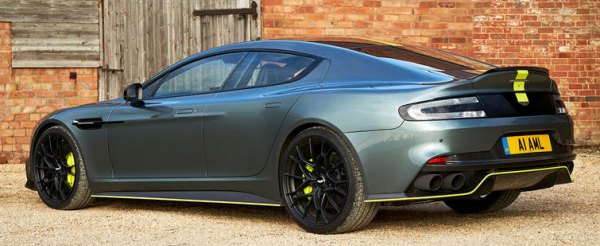
|
|
As
far as driving is concerned, nothing in the 4-door world can quite
match it
|
|
The AMR has some cosmetic upgrades, most notably the carbon-fiber aero
kits, a more pronounced boot lid spoiler, a diffuser, a pair of
foglamps, a black mesh grille and special AMR paint scheme. The bonnet
is now made of carbon-fiber and has larger ventilation holes. That
said, the AMR is no lighter than the last Rapide S, strangely. The
chassis upgrade is subtle. Ride height is dropped by 10mm. Adaptive
dampers are recalibrated to be stiffer. The brakes have been upgraded
to carbon-ceramic items, which need the larger 21-inch wheels and lower
profile Michelin Pilot Super Sport rubbers.
The handling and ride is tuned by ex-Lotus test engineer Matt Becker.
This is evident on typical British B-roads, where the AMR feels a tad
stiffer than the Rapide S, but it still absorbs bumps remarkably well.
Body control is superb for a car so big. Balances even more so. The
hydraulic steering is linear and feelsome. The brakes are dependable.
The big Aston remains the only 4-door on the market that truly feels
agile, adjustable and absorbent. It is not overloaded with power and
grip, just the right amount and in a progressive way to help you
exploiting the chassis. It is a sports car in its heart.
What a pity we are going to lose such a great driving machine. Yes, at
£200K it is overpriced. Its interior is outdated (even with a new
carbon-fiber center console), its rear seats are super-cramped and its
electronic equipment is stone-age. As far as driving is concerned,
nothing in the 4-door world can quite match it. This reminds us how the
motoring world goes wrong. A great era ends here.
|
Verdict:     |
|